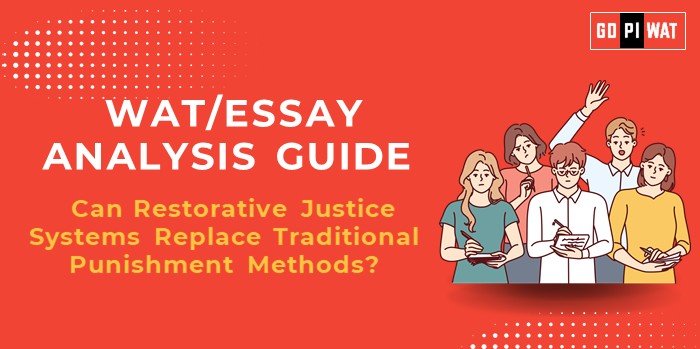📋 Written Ability Test (WAT) Analysis Guide: Can Restorative Justice Systems Replace Traditional Punishment Methods?
🌐 Understanding Restorative Justice’s Importance
Restorative justice redefines criminal justice by balancing punishment with rehabilitation. It prioritizes healing for victims, accountability for offenders, and community harmony, offering an alternative to punitive systems. Its emphasis on societal well-being aligns with modern trends in law and policy.
📝 Effective Planning and Writing
- ⏱️ Time Allocation:
- Reading & Planning: 5 minutes
- Writing: 20 minutes
- Review: 5 minutes
- 📋 Preparation Tips:
- Research statistics on recidivism and success rates in restorative justice systems.
- Analyze challenges and examples from diverse countries like Norway and New Zealand.
🎯 Introduction Techniques for Essays
- ⚖️ Contrast Approach: “While traditional systems focus on punishment, restorative justice seeks healing and reintegration, questioning the effectiveness of punitive measures.”
- 🔧 Solution-Based Approach: “With crime rates escalating globally, restorative justice emerges as a viable solution for sustainable societal harmony.”
📊 Structuring the Essay Body
1. Achievements:
- 📉 Reduced recidivism rates in countries like Norway and New Zealand.
- ✔️ Increased victim satisfaction through participatory processes.
- 🤝 Enhanced community healing by involving all stakeholders in resolving conflicts.
2. Challenges with Comparative Analysis:
- ❌ Resistance: Societal and institutional reluctance to shift from punitive systems.
- ⚖️ Emotional Barriers: Victims may prefer retribution over reconciliation.
- 🚫 Limitations: Ineffectiveness in handling severe crimes like murder or sexual violence.
3. Future Outlook:
- 🤖 Integration with AI for efficient mediation and case resolution.
- 🌍 Expanding restorative justice frameworks to diverse legal systems.
- 📚 Incorporating restorative practices in school curriculums to foster early acceptance.
📖 Concluding Effectively
- ⚖️ Balanced Perspective: “Restorative justice complements traditional systems, ensuring fairness and societal well-being.”
- 🌍 Global Comparison: “Drawing from Norway’s success, countries like India can reform justice systems through restorative practices.”
💡 Recommendations for Sustainable Progress
- 📢 Launch public awareness campaigns to build trust in restorative methods.
- 📚 Introduce restorative justice principles in educational curriculums to nurture empathy and accountability.
- 💻 Develop technology-driven mediation platforms for broader accessibility.
📄 Sample Short Essays on Restorative Justice
1. Balanced Perspective: “Restorative justice bridges societal gaps, emphasizing rehabilitation. While effective for non-violent crimes, it complements rather than replaces punitive systems for serious offenses.”
2. Solution-Oriented: “Restorative justice offers a cost-effective, humane alternative, addressing victims’ needs and offenders’ reintegration. Its success demands societal acceptance and policy integration.”
3. Global Comparison: “Countries like Norway demonstrate restorative justice’s efficacy, reducing recidivism significantly. India can adopt similar models, addressing local challenges effectively.”


